MARIANI’S
Virtual
Gourmet
December 29,
2019
NEWSLETTER
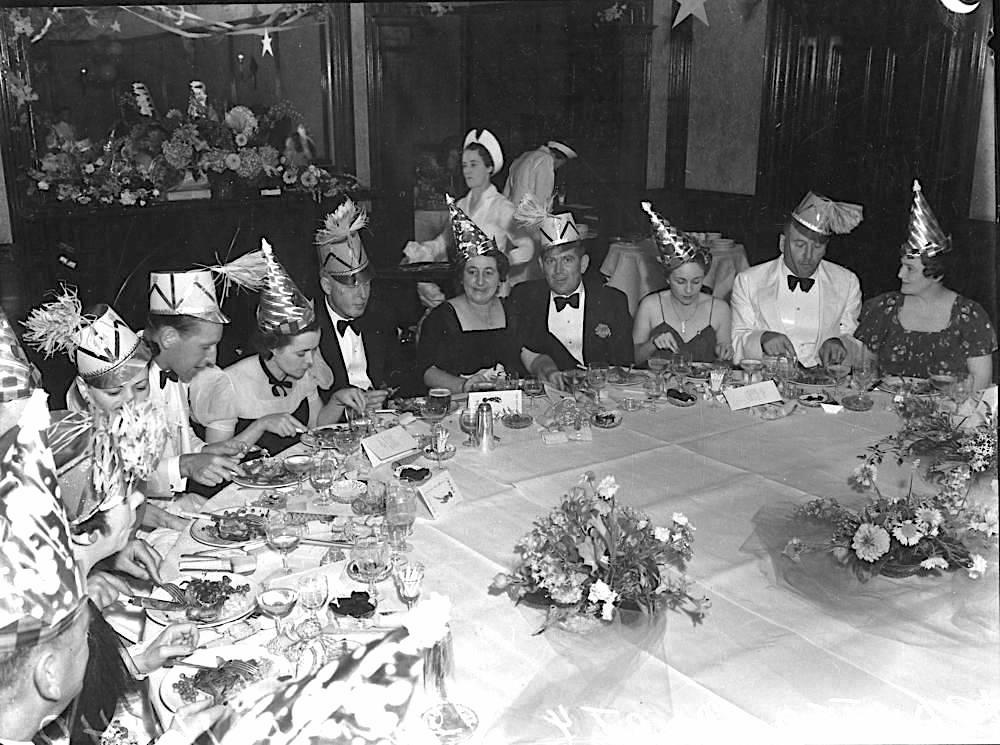
❖❖❖
IN THIS ISSUE
EATING VERY HAPPILY IN PARIS
Part One
By John Mariani
NEW YORK CORNER
BOTTINO
By John Mariani
NOTES FROM THE WINE CELLAR
FIRRIATO: SICILY'S MOST
INNOVATIVE WINERY
By John Mariani
❖❖❖
EATING VERY HAPPILY IN PARIS
Part One
By John Mariani
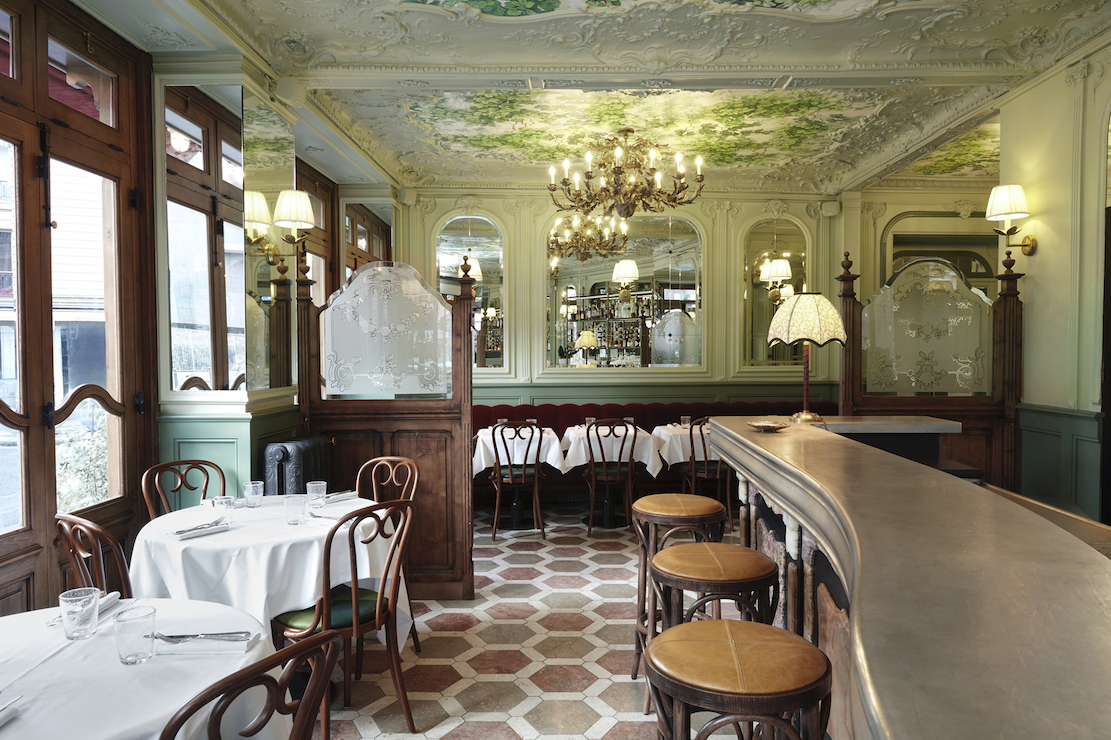
Le Chardenoux
Photo: Thomas Delhemmes
Only someone who has not eaten around Paris in the past five years, two years, or last year would be so ignorant to suggest the city’s culinary scene has grown staid, stale and stultified. In fact, there has never been a more exciting time to dine in Paris, where new restaurants with innovative menus are opening all the time and where classic cuisine is now not so entrenched as it is refreshed in the established grand salons. Just as Paris once opened itself to the global influences of foods in the age of exploration that added spices from the east and west to French larders, today’s access to more and more foods has given French chefs more to work with than ever before, and they have taken up the challenge with gusto. Here are two restaurants I visited this fall that prove what I mean.
LE CHARDENOUX
1 Rue de Jules Vallés
43714952
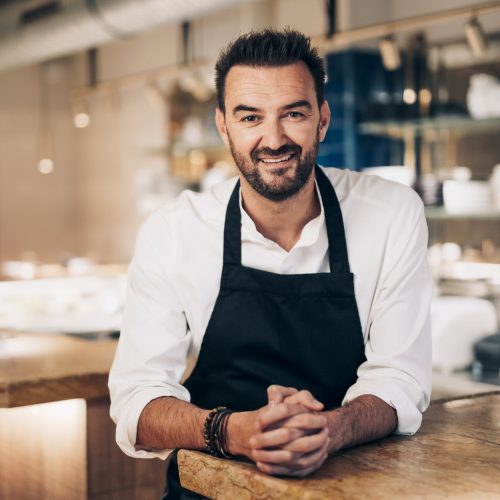 Chef/entrepreneur
Cyril Lignac, who hails from France’s Aveyron
region, has proven again and again that opening
and running a restaurant in Paris in this decade
is a winning proposition. After working at Alain
Passard’s illustrious Arpège, he became chef at La
Suite and began a TV career with his show “Oui
Chef!” His first restaurant, Le Quinzième
(recently closed after a decade) filled a niche
between deluxe and bistro
Chef/entrepreneur
Cyril Lignac, who hails from France’s Aveyron
region, has proven again and again that opening
and running a restaurant in Paris in this decade
is a winning proposition. After working at Alain
Passard’s illustrious Arpège, he became chef at La
Suite and began a TV career with his show “Oui
Chef!” His first restaurant, Le Quinzième
(recently closed after a decade) filled a niche
between deluxe and bistro 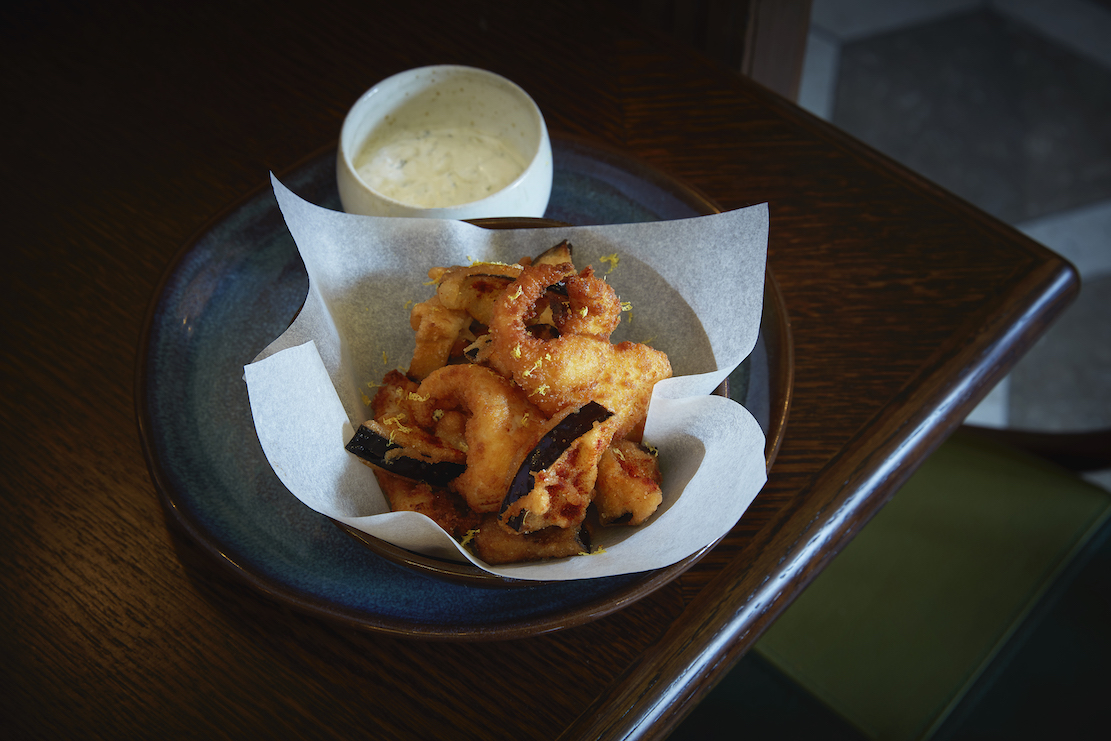 styles and
won a Michelin star in the process. He followed
that with a modern bistro, Aux Prés; a
seafood-sushi place called Le Bar des Prés; La
Pâtisserie; La Chocolaterie and, this year, the
Cocktail Bar Dragon.
styles and
won a Michelin star in the process. He followed
that with a modern bistro, Aux Prés; a
seafood-sushi place called Le Bar des Prés; La
Pâtisserie; La Chocolaterie and, this year, the
Cocktail Bar Dragon.
He took over a beloved 100-year-old bistro
named Le Chardenoux and re-fashioned it to look
like the brightest diadem in the 11th
arrondissement. It is an enchanting little place
done in an airy Art Nouveau flourish with a foliated ceiling, marble
tables and zinc bar, with perfect lighting and a
cheery sound level.
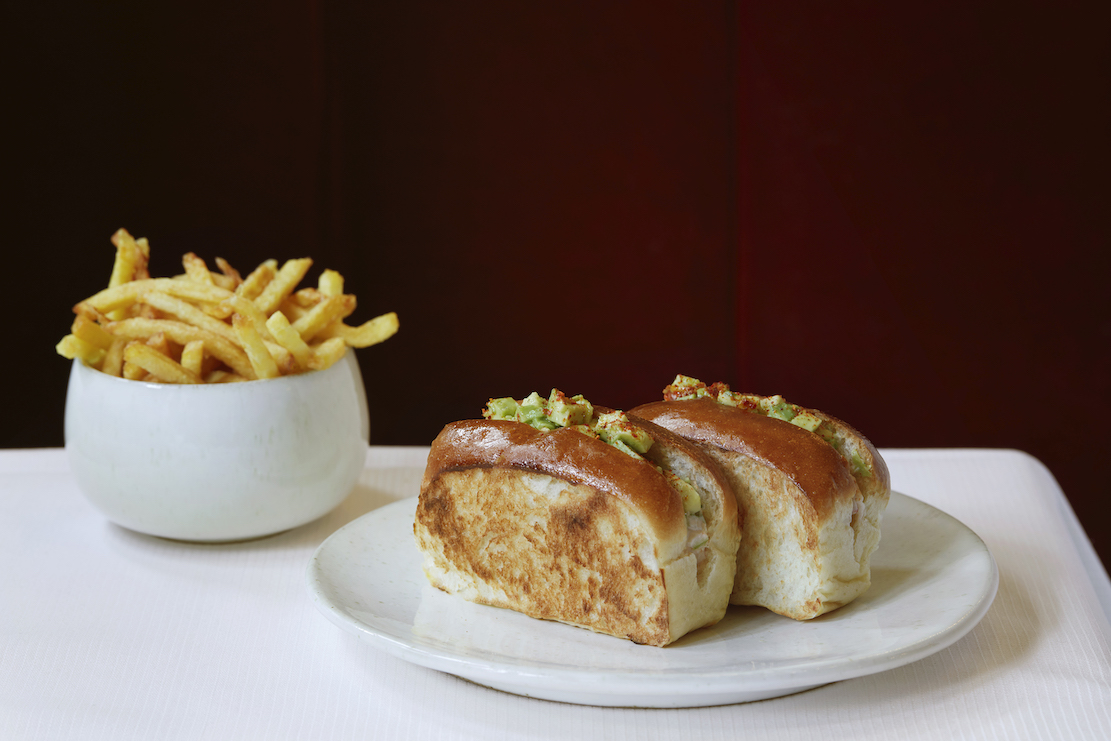 Lignac
calls Le Chardenoux a “restaurant de
la traditions,” but those traditions come
from all over the globe, right down to a terrific
New England lobster roll with celery, apple,
cocktail sauce and avocado (left). The
small menu offers raw shellfish as well as a very
appealing fritto
misto of sweet shrimp, zucchini and a spicy
mayonnaise (€18), quickly fried to a crispiness
that keeps the meat inside fluffy and tender. A
fanned-out crab galette
with avocado is tinged with Madras curry (€25),
and there is a delight called “crispy sushi” (€16)
made of lightly marinated wild salmon slightly
warm and placed atop buttered bread (below). I
can’t remember the last time I used the cliché of
food that “melts in your mouth,”
Lignac
calls Le Chardenoux a “restaurant de
la traditions,” but those traditions come
from all over the globe, right down to a terrific
New England lobster roll with celery, apple,
cocktail sauce and avocado (left). The
small menu offers raw shellfish as well as a very
appealing fritto
misto of sweet shrimp, zucchini and a spicy
mayonnaise (€18), quickly fried to a crispiness
that keeps the meat inside fluffy and tender. A
fanned-out crab galette
with avocado is tinged with Madras curry (€25),
and there is a delight called “crispy sushi” (€16)
made of lightly marinated wild salmon slightly
warm and placed atop buttered bread (below). I
can’t remember the last time I used the cliché of
food that “melts in your mouth,”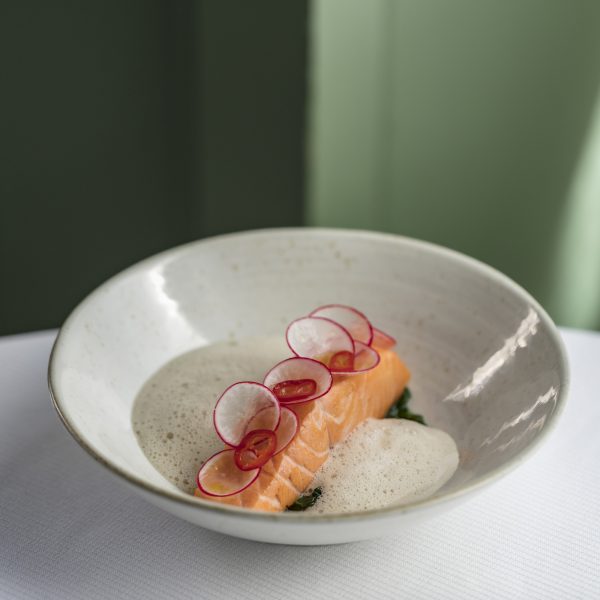 but with
his salmon it’s the absolute truth.
but with
his salmon it’s the absolute truth.
Truly classic French are his
fat morsels of goujons of
sole with eggplant tempura and tartar sauce (€29).
There is also pasta—every restaurant in Paris now
seems to serve pasta —a langoustine ravioli in a
light broth with cabbage (€25). Like all good
French chefs, Lignac does not skimp on the amount
of butter in his mashed potatoes side dish.
Desserts keep to French form,
with a perfect, shattering-crisp millefeuille with
praline (€12); French toast with raspberries and
pistachios (€12) and a Grand Cru chocolate biscuit
and passion fruit.
When the sun returns to Paris
in the spring, they’ll put tables outside Le
Chardenoux.
I’ll wish I were there.
 LA
PAGODE DE COS
LA
PAGODE DE COS
42 Avenue Gabriel
58-36-6060
It
would take some time to find a more exquisitely
decorated boutique hotel and restaurant than La
Réserve near the Champs-Élysées. This was formerly
the home of couturier Pierre Cardin, which
owner Michel Reybier has made over as an intimate
small hotel with the look of a 19th century
apartment in the Belle Epoque-Haussmann style, now
with a very 21st century indoor pool.
There are two restaurants, the
deluxe Le Gabriel, done in
Napoleonic décor, with both à la carte and a €295
menu, and the more casual La Pagode de Cos, which
has an outdoor garden attached. The “Cos” refers
to the Bordeaux château Cos d’Estournel, which
has, in fact, a pagoda-like tower. The sumptuous
furnishings at the restaurant are done in the
finest Chinoiserie, silks and satins. Had Marcel
Proust not chosen to sequester himself in his
cork-lined bedroom, La Pagode de Cos is what his
apartment might have looked like.
Chef Jérôme Bactel offers a
reasonable €85 menu in addition to à la carte,
which has a few Asian elements along with
Mediterranean and French fare on the one-page
menu. A lobster salad with an almond milk emulsion
(€48) had surprisingly large claws for a European
crustacean and therefore plenty of meat, and they
were sweet and impeccably cooked. His cream of porcini
soup with a parmesan foam (€22) was one of the
best soups I had on my trip to Paris, as velvety
as it was intensely flavorful.
 St.
Pierre had fine, firm and succulent flesh enhanced
simply with sautéed zucchini (€32), and a
straightforward, well-seasoned beef tartare (€41)
could only be better had the dice of the beef been
somewhat finer.
St.
Pierre had fine, firm and succulent flesh enhanced
simply with sautéed zucchini (€32), and a
straightforward, well-seasoned beef tartare (€41)
could only be better had the dice of the beef been
somewhat finer.
I’m always puzzled how so many
French chefs just can’t get Italian pasta right.
The rigatoni that day with eggplant and pecorino
(€29) was simple enough but hadn’t much flavor,
and, in an attempt at making it al dente,
it came out far too
chewy.
I hardly expected to find a Key
lime tart in Paris, but call it a calisson
acidule on a crispy caramelized almond crust
(€18) and I’ll happily devour it by any name.
Equally delicious was a raspberry macaroon with
caramelized peach cream (€19).
Often when I'm traveling alone,
I experience moments I would so like to share with
my wife. Next time I am in Paris, I think I'll
surprise her with dinner at La Pagode de Cos, not
least as a good excuse to wear that beautiful
dress she bought that day on the nearby
Champs-Élysée.
❖❖❖
By John Mariani
246 Tenth Avenue (near 24th Street)
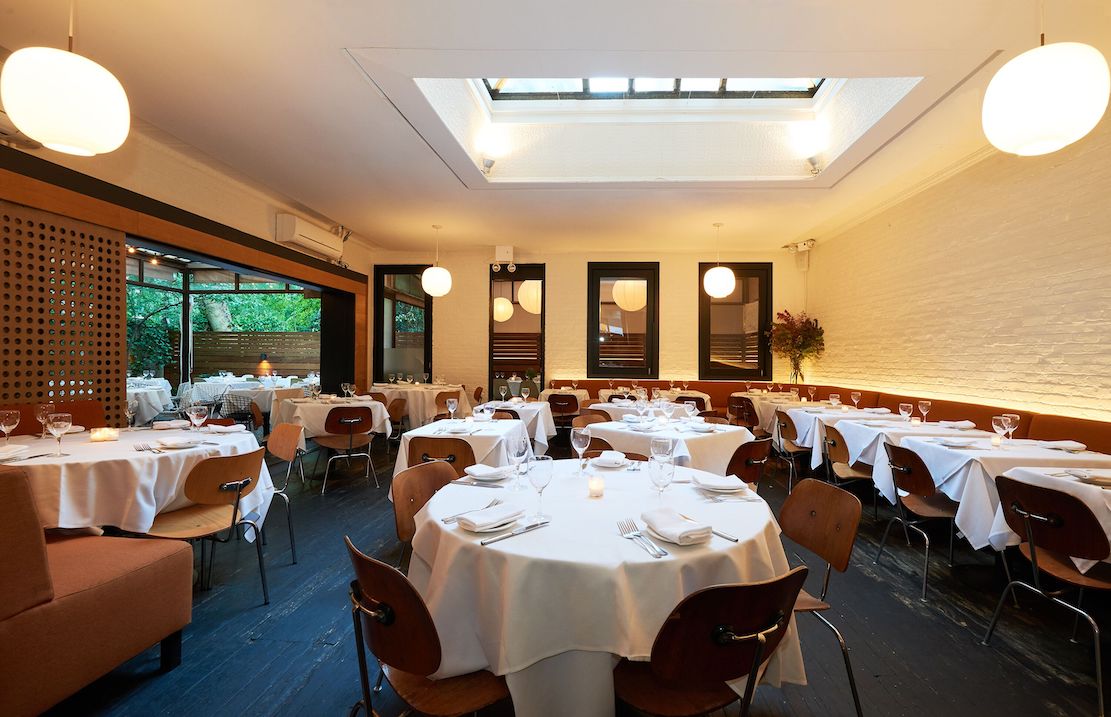
It is not an idle
question to ask if a non-Italian chef can truly
cook Italian food, because when it comes to
other national cuisines—Indian, Chinese,
Turkish, Russian, Thai —few who are not from
those regions ever attempt to make them. But the
assumption that Italian food is easy to learn
and master is a slippery slope indeed, with far
too many chefs who have never stepped foot in
Liguria or Emilia-Romagna wondering what the big
fuss is in making a good pesto or Bolognese ragù.
Worse, adding their own un-tested ideas to a
traditional or classic dish can show a total
misunderstanding about indigenous food.
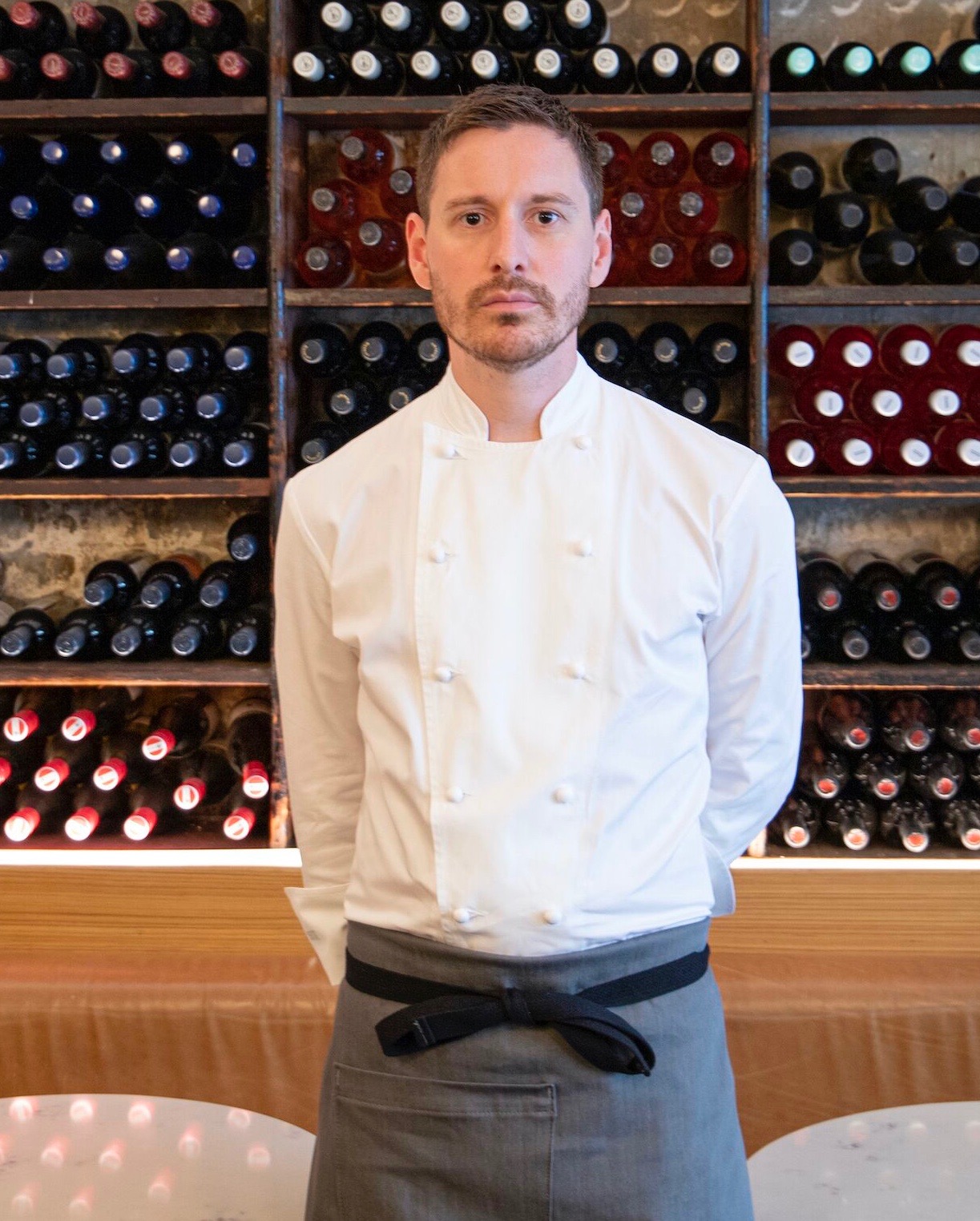 This came to mind the
other night at Bottino, the charming 21-year-old
restaurant in Chelsea owned by Danny Emerman and
Alessandro Prosperi (who also own Barocco) and now
headed by chef/partner Jamie Kenyon (left), who
has admirably mastered a range of Italian dishes
by respecting their roots and traditions. Case in
point, his cacio
e pepe, made with a pasta of the right shape
and texture—bavette—and
a
careful focus on how the cheese and crushed black
peppers are built so that the flavors and textures
are perfectly complementary (below). Kenyon
does not tack like so many non-Italian chefs,
This came to mind the
other night at Bottino, the charming 21-year-old
restaurant in Chelsea owned by Danny Emerman and
Alessandro Prosperi (who also own Barocco) and now
headed by chef/partner Jamie Kenyon (left), who
has admirably mastered a range of Italian dishes
by respecting their roots and traditions. Case in
point, his cacio
e pepe, made with a pasta of the right shape
and texture—bavette—and
a
careful focus on how the cheese and crushed black
peppers are built so that the flavors and textures
are perfectly complementary (below). Kenyon
does not tack like so many non-Italian chefs, 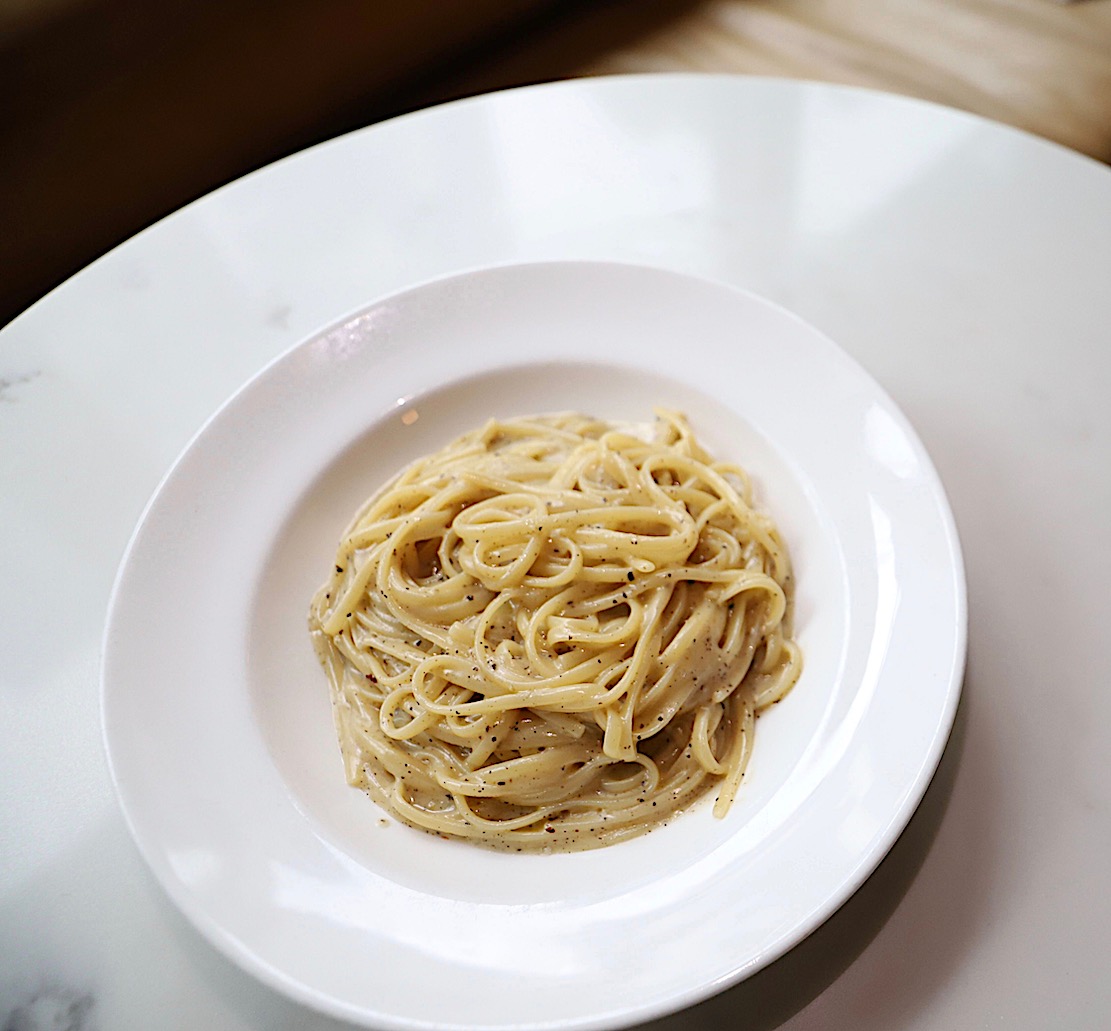 who feel a need to add
all sorts of other ingredients—kale, peas, cream,
sausage—that knock the dish completely out of
balance.
who feel a need to add
all sorts of other ingredients—kale, peas, cream,
sausage—that knock the dish completely out of
balance.
Kenyon,
who was born in Manchester, England, and cooked at
Daniel, Bar Boulud, Perla and La Serena, achieves
this balance with restraint and a menu that is the
ideal size for his kitchen and his staff to handle
well.
The premises are larger than
they would appear from the street, with a narrow
bar with tables leading to three rooms and a
glassed-in garden. The lighting is calming, the
noise level fine—no piped-in music—the walls
“gallery white,” the tablecloths simple and soft
and the chairs recycled Eames, all quite
minimalist. One could easily boot Bottino out and
install a Japanese restaurant without changing a
thing.
Begin with the piping hot,
crisp arancini
risotto croquettes with a shrimp broth, uni,
butternut squash and hot ‘nduja oil
($16), or the creamy duck and chicken liver mousse
with housemade brioche and Concord grape chutney
($16). Salads in Italian restaurants are often at
their best with just a few leaves, lemon and olive
oil, but Bottino’s apple and butter lettuce salad with
pomegranate, walnuts and Stilton cheese ($14),
while closer to a Waldorf salad than any in Italy,
is an excellent first course.
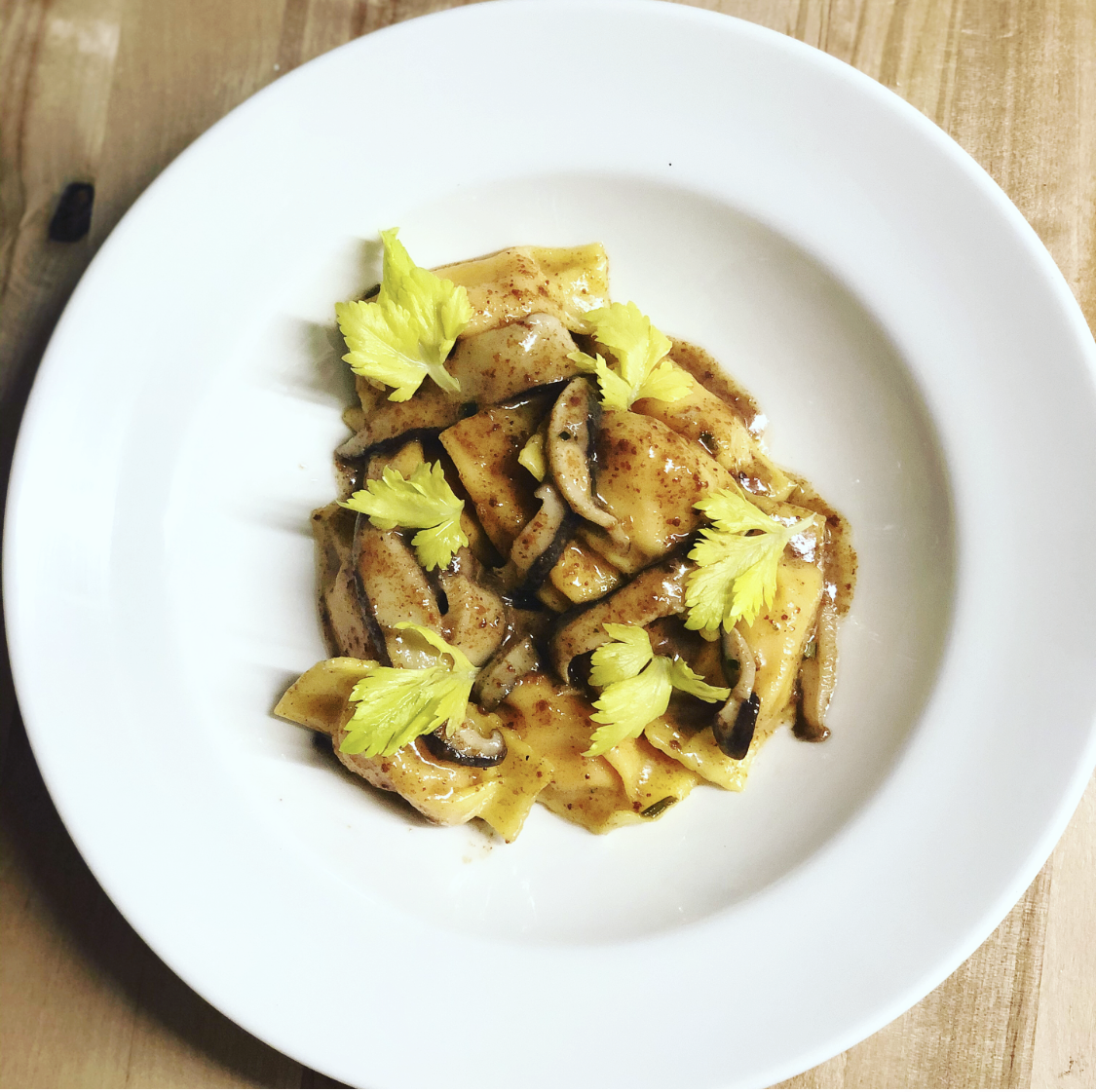 I tried
five pastas on the menu—portions are more than
ample as a main course but easy to share as a
first course—including that superb bavette cacio
e pepe ($22). The cavatelli
alla Norma ($22) is a classic southern
Italian dish made with charred eggplant, tomato,
pickled peppers and ricotta salata with a
pleasing, slight smokiness. Ricotta
made from goat’s cheese is made into plump gnocchi
(left)
with a lusty lamb neck ragù
($27), and, during the winter season, the
squash-stuffed agnolotti ($25) are not to be
missed. There was nothing wrong with a savory tagliatelle
alla Bolognese ($25) except for the
incorporation of too much tomato in a dish that
should be spare in its use.
I tried
five pastas on the menu—portions are more than
ample as a main course but easy to share as a
first course—including that superb bavette cacio
e pepe ($22). The cavatelli
alla Norma ($22) is a classic southern
Italian dish made with charred eggplant, tomato,
pickled peppers and ricotta salata with a
pleasing, slight smokiness. Ricotta
made from goat’s cheese is made into plump gnocchi
(left)
with a lusty lamb neck ragù
($27), and, during the winter season, the
squash-stuffed agnolotti ($25) are not to be
missed. There was nothing wrong with a savory tagliatelle
alla Bolognese ($25) except for the
incorporation of too much tomato in a dish that
should be spare in its use.
Main courses are generous and
you may well take some home. Nice, 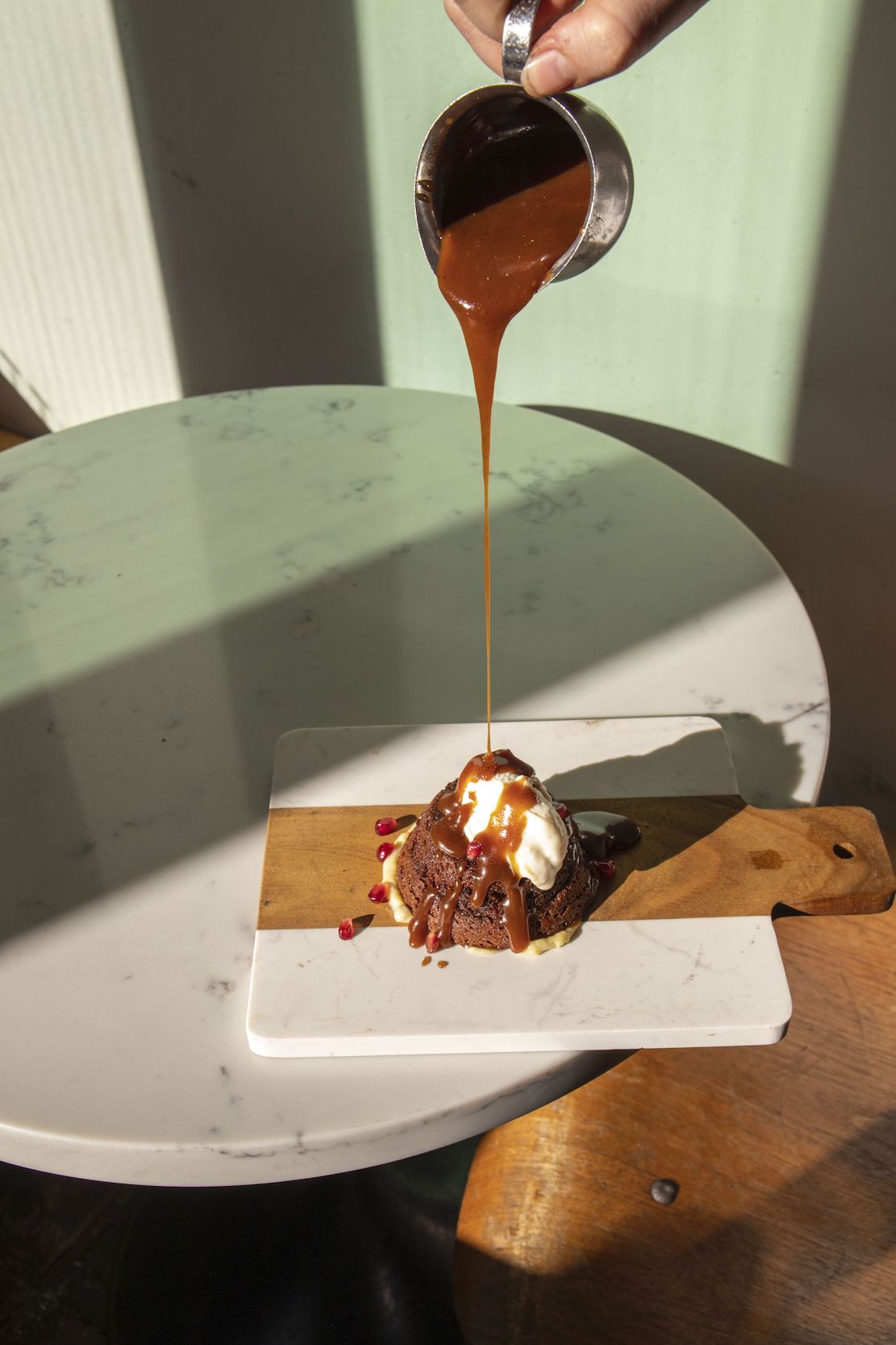 fatty pork cheeks are
braised in apple cider with granny smith apples
and served with an apple reduction and red cabbage
($25), while rack of lamb in a mild bagna cauda
with semolina gnocchi alla
romana
($36) was a feast; I ravaged the bones on
their own, then got around to the lamb itself.
Grilled octopus with ‘nduja
sausage, fingerling potatoes and pickled red onion
($28) was all right but too charred one evening.
fatty pork cheeks are
braised in apple cider with granny smith apples
and served with an apple reduction and red cabbage
($25), while rack of lamb in a mild bagna cauda
with semolina gnocchi alla
romana
($36) was a feast; I ravaged the bones on
their own, then got around to the lamb itself.
Grilled octopus with ‘nduja
sausage, fingerling potatoes and pickled red onion
($28) was all right but too charred one evening.
There is a whole roasted fish
each night (market price). Ours was black sea bass
served with crisped red potatoes that were tender,
sweet morsels that took on all the flavors of the
roasting pan and oil.
Annabel Sharahy is both sous-
and pastry chef, and her desserts ($12), while
respecting some Italian traditions, are quite
personalized, like her warm Tuscan bread pudding
with vanilla gelato; warn olive cake with vanilla gelato, balsamic,
tangerine and olive oil; and a Christmas-y
sticky toffee pudding with dates, sweet potato
custard and pomegranate toffee (right).
Manager Teddy
Namauleg oversees a largely Italian wine list with
good pricing and options, along with a cocktail
selection well worth considering, including a
chili-hot Margarita.
So,
in the hands of a team like Bottino’s, the simple
goodness of Italian food is exemplified by the use
of first-rate ingredients, thoughtful combinations
and rigorous attention to cooking times. Kenyon
has come a long way from Manchester in adopting cucina
all’Italiana as his own.
Bottino is open for lunch Tues.-Sat. and for dinner nightly.
SICILY'S MOST
INNOVATIVE PRODUCER
PART ONE
By John Mariani
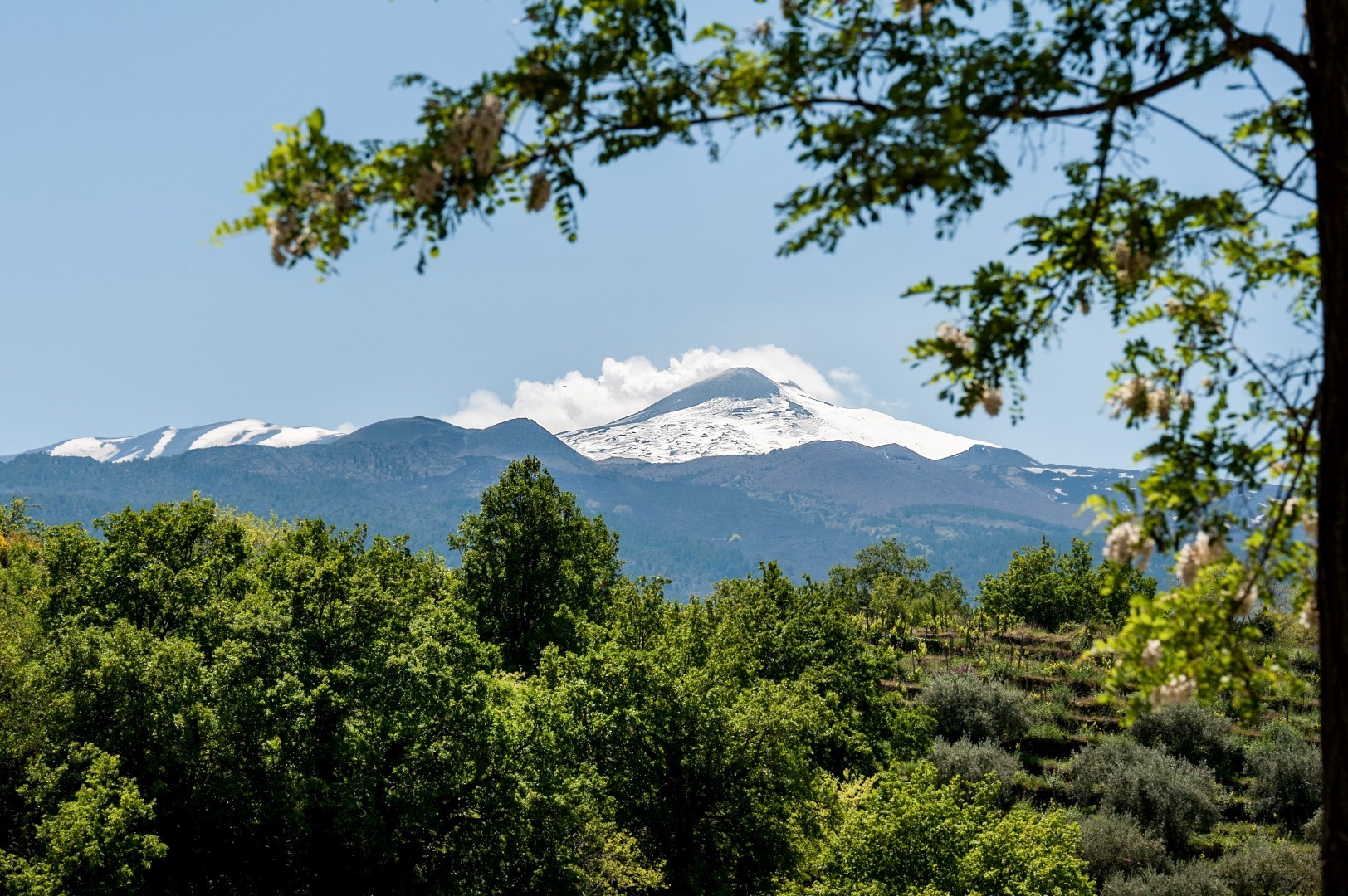
Mount Etna, Sicily
 Not until the 19th
century were certain, small estate Sicilian wines
recognized for their quality, but even well into
the 20th century there was little wine from Sicily
that was not produced in vast quantities by
cooperatives and sold cheap in the global market.
Not until the 19th
century were certain, small estate Sicilian wines
recognized for their quality, but even well into
the 20th century there was little wine from Sicily
that was not produced in vast quantities by
cooperatives and sold cheap in the global market.
I recall vividly back in the
early 1980s when a delegation of Sicilian
winemakers came to New York to show their wines to
the wine media, who, myself included, found every
bottle to be oxidized and largely undrinkable.
Later, in discussion with the New York Italian
Trade Commissioner, the vintners protested that
they had been making wines like this for thousands
of years and liked them to taste that way. To
which the Commissioner replied, wagging his
finger, “If you ever want to sell a bottle of your
wine in the international market, you have to
modernize, invest and acknowledge that oxidation
is a serious, distasteful flaw in table wines.”
The
Sicilians must have taken the advice, because, as
Bill Nesto and Frances di Savino show in their
book The
World of Sicilian Wine (2013), Sicilian wine
has improved measurably, especially among
innovative wine entrepreneurs and, too, among
cooperatives who have indeed made the investment
in modern technology to turn out well-made,
non-oxidized wines of regional character from
indigenous grapes like Catarrato, Grillo, Zbibbo,
Moscato Bianco, Nero d’Avola, Nerello Mascalese,
Perricone and many varietals more associated with
northern Europe, like Merlot, Chardonnay, Pinot
Noir and Cabernet Sauvignon. Producers like Planeta, Duca di Salaparuta,
Donnafugata and Regaleali have had considerable
success in the world market with good, clean,
fresh reds, whites and rosés. But none has started
from scratch to 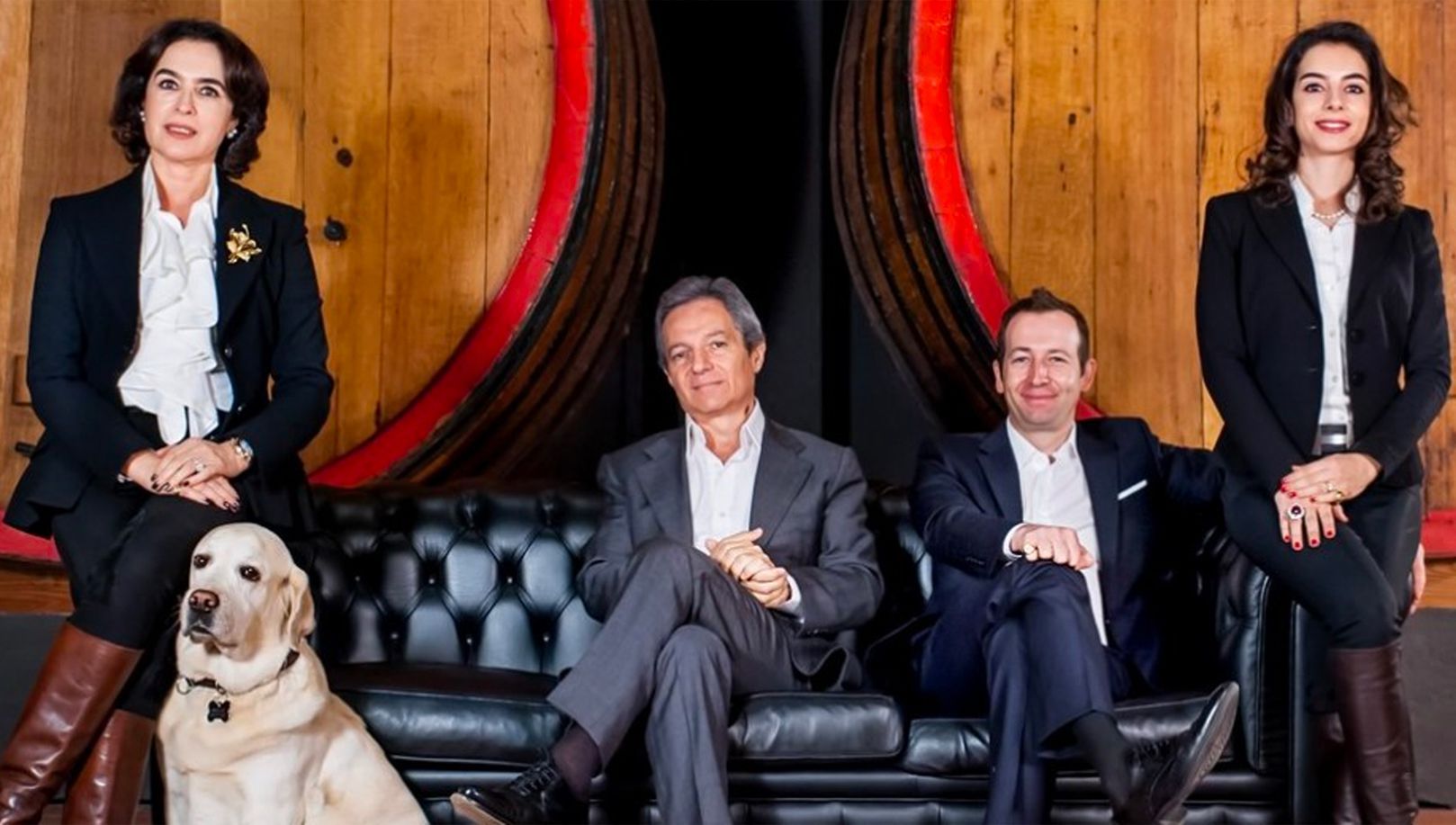 build a completely
hi-tech, wholly sustainable wine company as has
Firriato, whose vineyards are on both the east and
west coasts of Sicily, which I visited this fall.
build a completely
hi-tech, wholly sustainable wine company as has
Firriato, whose vineyards are on both the east and
west coasts of Sicily, which I visited this fall.
The company began only in 1984,
when Salvatore Di Gaetano sold off his
petrol company after finding land near Trapani on
the western coast where he saw the potential to
raise superior clones of traditional varietals
like Nero d’Avola, Perricone, Nerello Mascalese, Zibibbo,
Grillo and Catarratto. (There are at least 80
indigenous varietals in Sicily.) That original
production was increased with investments in the
east, near Mount Etna, where they’ve innovated
with more European varietals and took full
advantage of its rich volcanic soils. The first
vintage of Etna Rosso was 1994.
Di Gaetano,
63, now company president, has been joined by his
wife, Vinzia Novara, as CEO, their daughter Irene
as chairwoman, and her husband, COO Federico
Lombardo di Monte Iato (right), with whom I spent three
days in Sicily learning what Firriato has
accomplished and is planning for the future.
Federico, 39, is a man of
boundless energy—he climbed part of Mount Everest
through the jagged Rongbuk Glacier in Tibet—and
during my stay dragged me halfway up Mount Etna.
At least once a week he makes the eight-hour
round-trip drive from Trapani to Etna to tend both
estates.
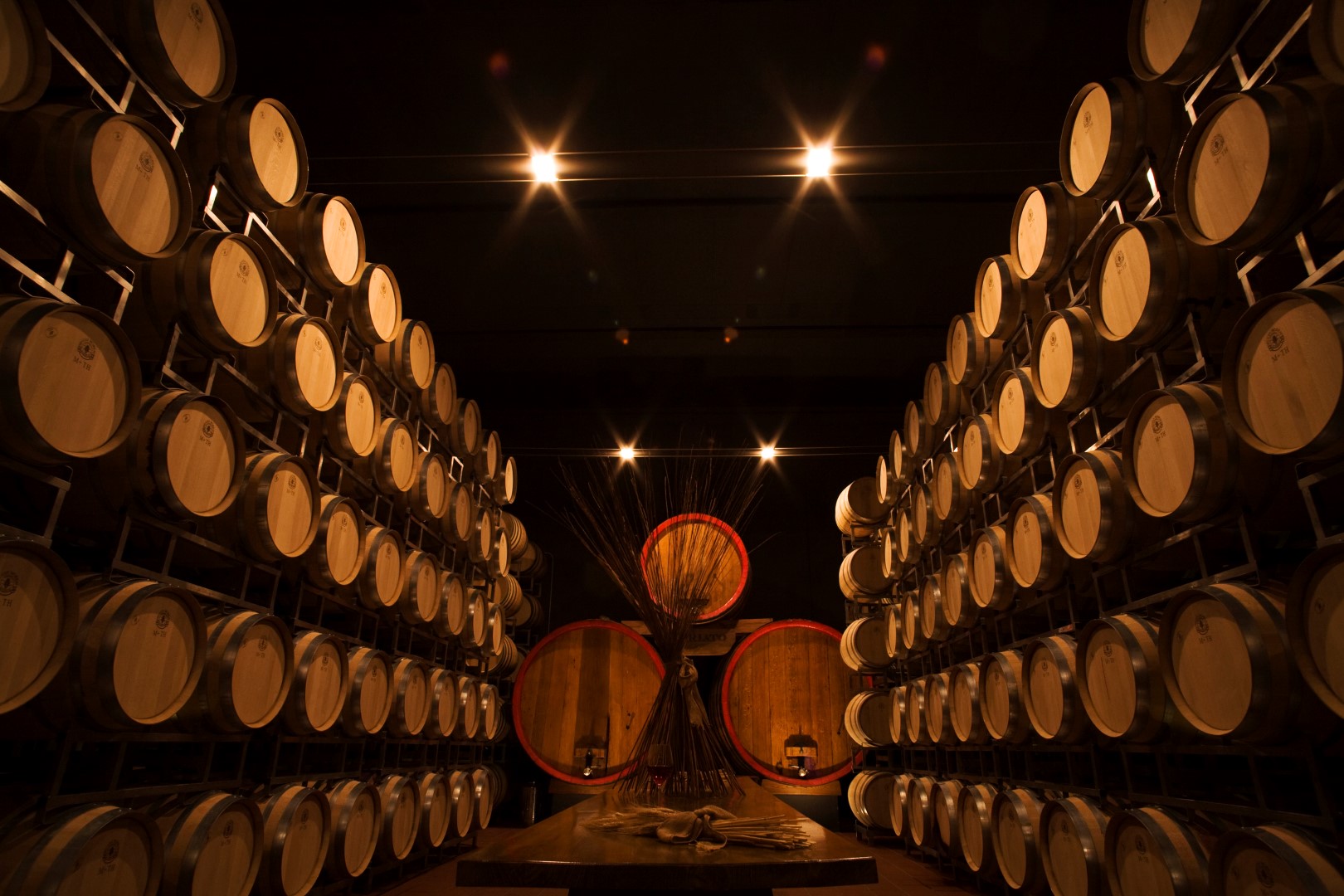 As
an honors graduate in IT and Management
Engineering, Federico focused immediately on
Firriato’s technology, establishing organic
management of vineyards, eco-friendly and
sustainable practices and experimental labs for
recovering Sicilian indigenous grapes. The
wineries are the first in Italy to be certified as
100% organic and carbon neutral.
As
an honors graduate in IT and Management
Engineering, Federico focused immediately on
Firriato’s technology, establishing organic
management of vineyards, eco-friendly and
sustainable practices and experimental labs for
recovering Sicilian indigenous grapes. The
wineries are the first in Italy to be certified as
100% organic and carbon neutral.
When I asked about the effects
of global warming, Federico was careful to say
that, “Global warming is unquestionably occurring,
because every kind of meteorological event is
becoming more frequent and more intense. What
science cannot yet tell us, because we lack the
long-term data, is how it is affecting
viticulture, but we do know it’s changing.” Thus,
grape growing practices at Firriato are based on
increasing the leaves that cover the vines of the
50- to 60- year-old vineyards. The selection of
the healthiest grapes is also part of the overall
program.
Lying in the shadow of Mount
Etna, Firriato produces wines that enjoy the
volcanic minerality detectable in the flavors of
the east coast wines. Federico has also cultivated
a vineyard of pre-phylloxera vines (an infestation
in Europe caused an 80% loss of vineyards in
Sicily in the 1880s) and he now makes a deep
purple Signum Aetne 2014 that is remarkably
complex, with firm tannins and a pleasing acidic
finish. It is made from Nero Mascalese and “other
relic wines in the vineyard.”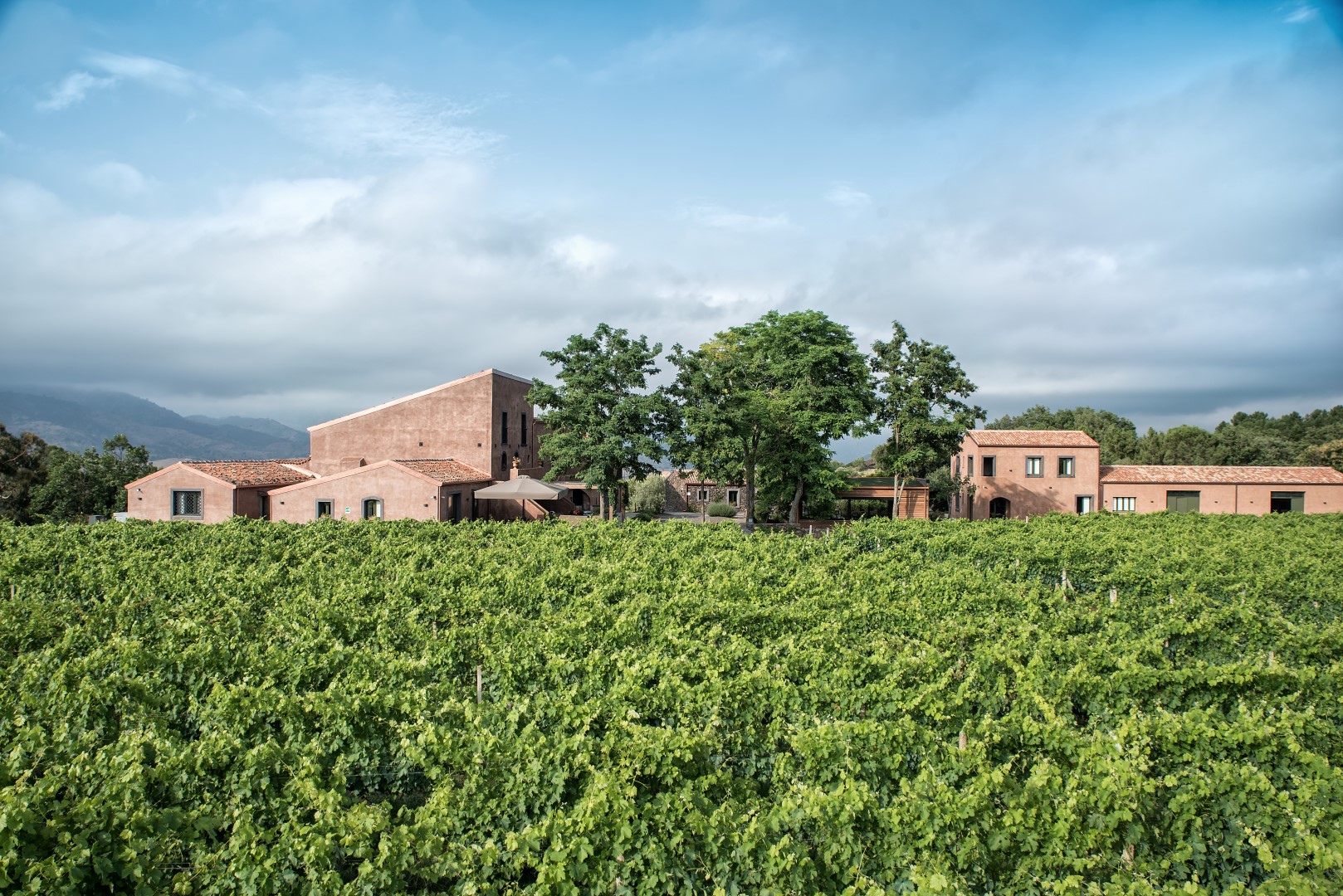
The Etna vines are the last of
the season to be harvested, and, after pressing
with state-of-the-art machinery, the wines are
aged in French oak in a room where constant
temperature and humidity are maintained (above).
The family has also been involved
with building first-class resorts on their
properties: Baglio Soria outside of Trapani is a
reclaimed farmers’ village, overlooking the
vineyards and the sea, with a restaurant and a
“wine experience” tour and tasting; Calamoni di
Favignana, on the small coastal island of
Favignana, has a secluded, very private residence
in the middle of the vineyard just meters from the
sea; Cavanera Etnea (right), in Etna, is also set
within the vineyards and boasts a superb
restaurant called La Reserva Bistrot with the full
range of Firriato’s wines offered. (I’ll be
writing about these in another article.)
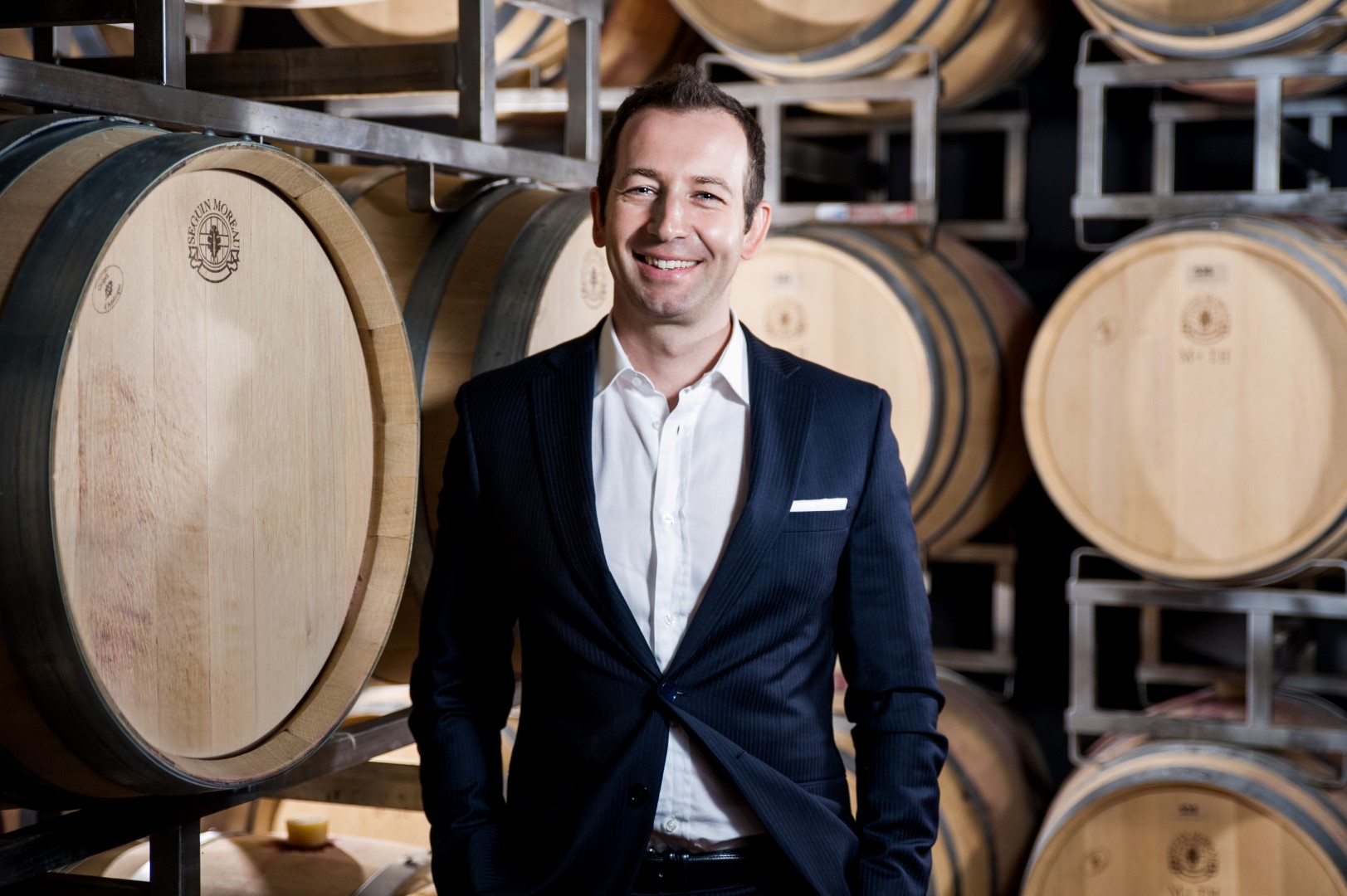 In a very
offhanded way, Federico (below) mentioned he is the
current scion of 37 generations of Sicilian
aristocracy dating back to the 12th century—a
count no less— though I found him to be very down
to earth and extremely funny (we sang “Surfin'
Bird” and “Wooly Bully” on our way to his Etna
vineyards) and looks like a younger version
Italian actor/director Roberto Benigni. In
Trapani, instead of living in one of the city’s
old palazzos, he has chosen to live fairly simply,
not least because he is so constantly on the move,
traveling internationally as well as on his weekly
trips to his far-flung vineyards.
In a very
offhanded way, Federico (below) mentioned he is the
current scion of 37 generations of Sicilian
aristocracy dating back to the 12th century—a
count no less— though I found him to be very down
to earth and extremely funny (we sang “Surfin'
Bird” and “Wooly Bully” on our way to his Etna
vineyards) and looks like a younger version
Italian actor/director Roberto Benigni. In
Trapani, instead of living in one of the city’s
old palazzos, he has chosen to live fairly simply,
not least because he is so constantly on the move,
traveling internationally as well as on his weekly
trips to his far-flung vineyards.
He
and Irene have a daughter named Elidea, from the
Greek for “goddess of the sun.” He keeps promising
Irene that one day he’ll finish the construction
of a home on Favignana. Fortunately, as chairwoman
of the company, Irene has plenty to occupy her
time until Federico delivers on that promise.
BET IT DIDN'T TASTE LIKE
CHICKEN
"Exes Harry Styles and Kendall Jenner Catch
Up Over a Dinner of Cod Sperm and Water Scorpion,"
TOO MUCH TIME ON YOUR HANDS

"The pizza toast was like liturgy, like an
old friend comforting me as I wept into my hands.
The pizza toast was everything I needed it to be at
the very moment it arrived."—Craig Modan, "I Walked 600 Miles Across Japan for Pizza
Toast
One man’s epic quest
to savor the fading beauty of Japan’s traditional
cafes," Eater.com
(
Any of John Mariani's books below may be ordered from amazon.com.
 The Hound in Heaven
(21st Century Lion Books) is a novella, and
for anyone who loves dogs, Christmas, romance,
inspiration, even the supernatural, I hope you'll find
this to be a treasured favorite. The story
concerns how, after a New England teacher, his wife and
their two daughters adopt a stray puppy found in their
barn in northern Maine, their lives seem full of promise.
But when tragedy strikes, their wonderful dog Lazarus and
the spirit of Christmas are the only things that may bring
his master back from the edge of despair.
The Hound in Heaven
(21st Century Lion Books) is a novella, and
for anyone who loves dogs, Christmas, romance,
inspiration, even the supernatural, I hope you'll find
this to be a treasured favorite. The story
concerns how, after a New England teacher, his wife and
their two daughters adopt a stray puppy found in their
barn in northern Maine, their lives seem full of promise.
But when tragedy strikes, their wonderful dog Lazarus and
the spirit of Christmas are the only things that may bring
his master back from the edge of despair. WATCH THE VIDEO!
“What a huge surprise turn this story took! I was completely stunned! I truly enjoyed this book and its message.” – Actress Ali MacGraw
“He had me at Page One. The amount of heart, human insight, soul searching, and deft literary strength that John Mariani pours into this airtight novella is vertigo-inducing. Perhaps ‘wow’ would be the best comment.” – James Dalessandro, author of Bohemian Heart and 1906.
“John Mariani’s Hound in Heaven starts with a well-painted portrayal of an American family, along with the requisite dog. A surprise event flips the action of the novel and captures us for a voyage leading to a hopeful and heart-warming message. A page turning, one sitting read, it’s the perfect antidote for the winter and promotion of holiday celebration.” – Ann Pearlman, author of The Christmas Cookie Club and A Gift for my Sister.
“John Mariani’s concise, achingly beautiful novella pulls a literary rabbit out of a hat – a mash-up of the cosmic and the intimate, the tragic and the heart-warming – a Christmas tale for all ages, and all faiths. Read it to your children, read it to yourself… but read it. Early and often. Highly recommended.” – Jay Bonansinga, New York Times bestselling author of Pinkerton’s War, The Sinking of The Eastland, and The Walking Dead: The Road To Woodbury.
“Amazing things happen when you open your heart to an animal. The Hound in Heaven delivers a powerful story of healing that is forged in the spiritual relationship between a man and his best friend. The book brings a message of hope that can enrich our images of family, love, and loss.” – Dr. Barbara Royal, author of The Royal Treatment.
 |
The Encyclopedia of American Food and Drink by John F. Mariani (Bloomsbury USA, $35) Modesty forbids me to praise my own new book, but let me proudly say that it is an extensive revision of the 4th edition that appeared more than a decade ago, before locavores, molecular cuisine, modernist cuisine, the Food Network and so much more, now included. Word origins have been completely updated, as have per capita consumption and production stats. Most important, for the first time since publication in the 1980s, the book includes more than 100 biographies of Americans who have changed the way we cook, eat and drink -- from Fannie Farmer and Julia Child to Robert Mondavi and Thomas Keller. "This book is amazing! It has entries for everything from `abalone' to `zwieback,' plus more than 500 recipes for classic American dishes and drinks."--Devra First, The Boston Globe. "Much needed in any kitchen library."--Bon Appetit. |
"Eating Italian will never be the same after reading John Mariani's entertaining and savory gastronomical history of the cuisine of Italy and how it won over appetites worldwide. . . . This book is such a tasteful narrative that it will literally make you hungry for Italian food and arouse your appetite for gastronomical history."--Don Oldenburg, USA Today. "Italian
restaurants--some good, some glitzy--far
outnumber their French rivals. Many of
these establishments are zestfully described
in How Italian Food Conquered the World, an
entertaining and fact-filled chronicle by
food-and-wine correspondent John F.
Mariani."--Aram Bakshian Jr., Wall Street
Journal.
"Equal parts
history, sociology, gastronomy, and just
plain fun, How Italian Food Conquered the
World tells the captivating and delicious
story of the (let's face it) everybody's
favorite cuisine with clarity, verve and
more than one surprise."--Colman Andrews,
editorial director of The Daily
Meal.com. "A fantastic and fascinating
read, covering everything from the influence
of Venice's spice trade to the impact of
Italian immigrants in America and the
evolution of alta cucina. This book will
serve as a terrific resource to anyone
interested in the real story of Italian
food."--Mary Ann Esposito, host of PBS-TV's
Ciao
Italia. "John Mariani has written the
definitive history of how Italians won their
way into our hearts, minds, and
stomachs. It's a story of pleasure over
pomp and taste over technique."--Danny Meyer,
owner of NYC restaurants Union Square
Cafe, The Modern, and Maialino.
|
 |
 |
 |
 |
 |
 |
 |
 |
 Everett Potter's Travel Report:
Everett Potter's Travel Report: 
 Eating Las Vegas
JOHN CURTAS has been covering the Las Vegas
food and restaurant scene since 1995. He is
the co-author of EATING LAS VEGAS – The 50
Essential Restaurants (as well as
the author of the Eating Las Vegas web site: www.eatinglasvegas.
He can also be seen every Friday morning as
the “resident foodie” for Wake Up With the
Wagners on KSNV TV (NBC) Channel 3 in
Las Vegas.
Eating Las Vegas
JOHN CURTAS has been covering the Las Vegas
food and restaurant scene since 1995. He is
the co-author of EATING LAS VEGAS – The 50
Essential Restaurants (as well as
the author of the Eating Las Vegas web site: www.eatinglasvegas.
He can also be seen every Friday morning as
the “resident foodie” for Wake Up With the
Wagners on KSNV TV (NBC) Channel 3 in
Las Vegas.
MARIANI'S VIRTUAL GOURMET
NEWSLETTER is published weekly. Publisher: John Mariani. Editor: Walter Bagley. Contributing Writers: Christopher Mariani,
Robert Mariani, Misha Mariani, John A. Curtas, Gerry Dawes, Geoff Kalish,
and Brian Freedman. Contributing
Photographer: Galina Dargery. Technical
Advisor: Gerry
McLoughlin.
If you wish to subscribe to this
newsletter, please click here: http://www.johnmariani.com/subscribe/index.html
© copyright John Mariani 2019

